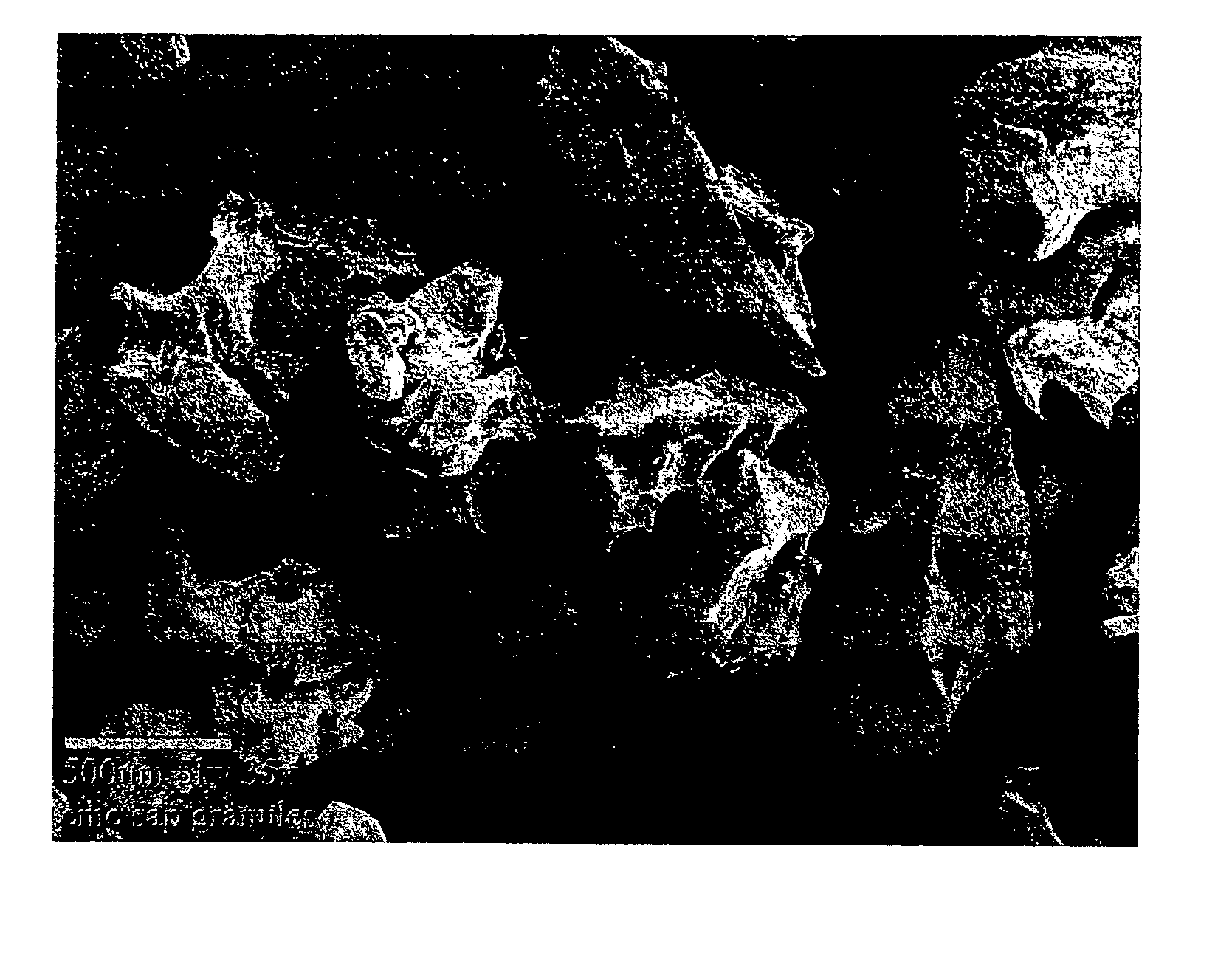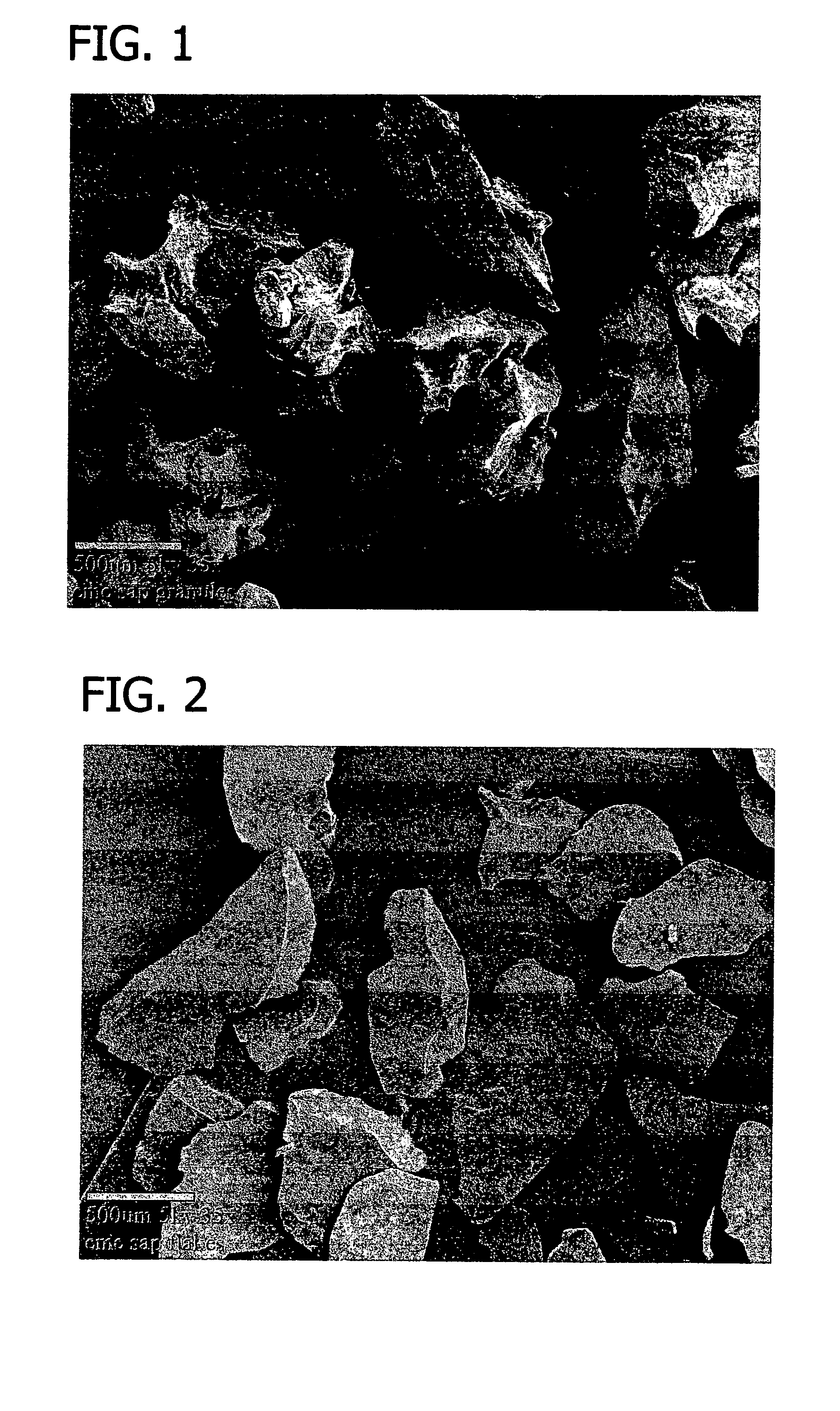Absorbent articles having increased absorbency of complex fluids
a technology of complex fluids and absorbent articles, which is applied in the field of absorbent articles, can solve the problems of reducing the absorption capacity of polymers, affecting the absorption efficiency of complex bodily fluids such as plasma, blood, mucus, and liquid bowel movement that are particularly difficult to effectively absorb into superabsorbent products, and achieve excellent absorption speed and capacity
- Summary
- Abstract
- Description
- Claims
- Application Information
AI Technical Summary
Benefits of technology
Problems solved by technology
Method used
Image
Examples
example 1
[0055] In this Example, superabsorbent particles in flake form and superabsorbent particles in granular (spherical-like) form were manufactured and recovered using a pre-polymer process as described herein. The recovered flake superabsorbent particles and granular superabsorbent particles had a particle size distribution of less than about 850 micrometers.
[0056] Into 1000 grams of distilled water was added and dissolved 20 grams of carboxymethyl cellulose linear polymer, available from Hercules Inc. (Wilmington Del.) (CMC-7H4F). To the homogeneous aqueous solution was added 1.5 grams of BACOTE solution containing 40% ammonium zirconium carbonate (Magnesium Elektron, Inc., Flemington, N.J.) as a latent crosslinking agent. The resulting solution was stirred vigorously in a one gallon Kitchen Aid mixer for 90 minutes to achieve a high degree of uniformity.
[0057] After the mixing was complete and a high degree of uniformity achieved, one half of the solution was transferred into a 100...
example 2
[0059] In this Example, bench testing was performed to evaluate the Centrifuge Retention Capacity for saline of the granule and flake superabsorbent particles prepared in Example 1.
[0060] The Centrifuge Retention Capacity Test measures the ability of superabsorbent gel particles (granules and flakes in this Example) to retain a certain liquid (i.e., saline or blood) therein after being saturated and subjected to centrifugation under a controlled set of conditions. The resultant retention capacity is stated as grams of liquid retained per gram weight of the sample (g / g). The sample to be tested is prepared from superabsorbent particles which are prescreened through a U.S. standard 30 mesh screen and retained on a U.S. standard 50 mesh screen. As a result, the sample comprises particles sized in the range of from about 300 micrometers to about 600 micrometers. The particles can be prescreened manually or mechanically and are stored in a sealed airtight container until testing.
[0061]...
example 3
[0066] In this Example, bench testing was performed to evaluate the Centrifuge Retention Capacity in blood of the granule and flake superabsorbent particles prepared in Example 1.
[0067] In this Example, the granule and flake superabsorbent particles evaluated had a particle size distribution of less than about 850 micrometers. The centrifuge retention capacity was measured by first introducing 0.04 grams of the prescreened sample (see Example 2) superabsorbent particles into a plastic ring having a diameter of about 50 millimeters with a 160 micrometer mesh screen attached to the bottom. Prior to the introduction of the superabsorbent particles, the plastic ring and mesh screen were weighed. The superabsorbent particles were separated as evenly as possible over the screen at the bottom of the plastic ring. Four replicates for each type of superabsorbent particle was prepared.
[0068] Swine blood (Cocalico Biologicals, Inc., Reamstown, Pa.) was adjusted to about 35% hematocrit by dil...
PUM
| Property | Measurement | Unit |
|---|---|---|
| Fraction | aaaaa | aaaaa |
| Fraction | aaaaa | aaaaa |
| Fraction | aaaaa | aaaaa |
Abstract
Description
Claims
Application Information
 Login to View More
Login to View More - R&D
- Intellectual Property
- Life Sciences
- Materials
- Tech Scout
- Unparalleled Data Quality
- Higher Quality Content
- 60% Fewer Hallucinations
Browse by: Latest US Patents, China's latest patents, Technical Efficacy Thesaurus, Application Domain, Technology Topic, Popular Technical Reports.
© 2025 PatSnap. All rights reserved.Legal|Privacy policy|Modern Slavery Act Transparency Statement|Sitemap|About US| Contact US: help@patsnap.com


